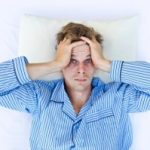This upcoming week is National Sleep Awareness Week, which runs from March 6 to 13, 2016, highlighting key sleep disorders and problems such as obstructive sleep apnea (OSA), parasomnia, and sleep paralysis.
Sleep is an integral part of our health, and poor sleep or lack thereof can wreak havoc on our overall health. This is why it is so important to become aware of the many common sleep problems there are, so that you can not only educate yourself, but go out and receive the treatment you need in order to improve your sleep.
Advertisement
Here are just some of Bel Marra Health’s news articles regarding sleep disorders so you can recognize the symptoms and talk to your doctor about your sleep concerns.
Sleep apnea patients face higher pneumonia risk
People with sleep apnea often snore loudly, and are tired after a full night’s sleep because their sleep cycle frequently is interrupted. Problem is, sleep apnea often goes undiagnosed for many years because there isn’t a simple test that can diagnose the condition.
Let’s break it down further. The two main types of sleep apnea are obstructive sleep apnea and central sleep apnea. Obstructive is more common and happens when the muscles in the throat relax during sleep, which results in a collapsing or blocking of the airway. It can affect anyone, but is more common in obese individuals.
Obstructive sleep apnea has been linked to heart disease and cognitive impairment. So be warned: if you or your loved one could have this condition, don’t shrug it off (and sleep in separate quarters). See your doctor.
Central sleep apnea, on the other hand, is less common and occurs when the brain doesn’t send appropriate signals to the muscles that control breathing. While central sleep apnea can affect anyone, it is much more common in people with other medical conditions or who are taking certain medications. Continue reading…
 Obstructive sleep apnea, sleep disorders may contribute to multiple sclerosis fatigue
Obstructive sleep apnea, sleep disorders may contribute to multiple sclerosis fatigue
Obstructive sleep apnea (OSA) and sleep disorders may contribute to multiple sclerosis fatigue. Sleep problems and lack of sleep is a common problem in multiple sclerosis (MS) patients with nearly 50 percent of MS patients experiencing sleep disturbances, this according to Multiple Sclerosis Trust.
Poor or lack of sleep can have a negative impact on just about anyone’s life but more so in MS patients as it can contribute to relapses and contribute to worsened symptoms.
Patients with multiple sclerosis may experience a slew of sleeping problems including difficulty falling asleep, difficulty staying asleep and even having a hard time going back to sleep once awoken. Understanding and uncovering the underlying cause of sleep problems can aid in treatment options and in turn improve sleep. Continue reading…
 Parasomnia sleep disorders and link with obstructive sleep apnea
Parasomnia sleep disorders and link with obstructive sleep apnea
With 40 million Americans suffering from sleep disorders, research into sleep behavior is constant, and in recent years experts have been able to link parasomnia sleep disorders with sleep apnea.
Parasomnia sleep disorder is a group of abnormal behaviors that can take place when a person in sleeping. Some sleep disorder parasomnias include sleep-related eating disorder, nightmares, sleep walking, sleep paralysis and sleep aggression.
Sleep includes two different states; rapid eye movement sleep or REM, and non-rapid eye movement or NREM. These two states alternate throughout the sleep cycle. Parasomnia can take place in any state of sleep, as well as during a sleep-wake transition. They can also be classified into two syndromes. For instance, sleep disorders of arousal tend to happen during NREM. REM parasomnias are more likely to take place during the later half of the sleep period when REM sleep is most abundant. Continue reading…
 Signs you have a sleep disorder
Signs you have a sleep disorder
Sleep and health go hand-in hand, with insufficient sleep being associated with chronic diseases, depression, motor vehicle accidents and occupational accidents. It is important to understand and be aware of the causes and symptoms of sleep disorders.
According to the Centers for Disease Control and Prevention (CDC), 50 to 70 million American adults have sleep or wakefulness disorders. Sleep plays an important role in our overall well-being. Getting the right amount of sleep and good quality sleep helps protect both our physical and mental health.
Advertisement
Studies show that during sleep our brain is forming new pathways to help us process, learn and remember. When we have had a good night’s sleep we are able to pay attention, make decisions and be creative. The opposite occurs when we experience one or more type of sleep disorder. With sleep disorders we have more trouble making decisions and solving problems. We also find it more challenging to control our emotions and behaviour. Coping with change can be really hard, too. Continue reading…
 Sleep paralysis: Causes, symptoms and how to cope
Sleep paralysis: Causes, symptoms and how to cope
Sleep paralysis can occur in the transition from wakefulness to sleep or from sleep into wakefulness – these are known as hypnagogic or predormital sleep paralysis and hypnopompic sleep paralysis. Hypnagogic is the process where your body relaxes to enter sleep. Normally you begin to lose awareness during this time, but with sleep paralysis you may still keep consciousness, and thus you will be aware that you cannot move or speak.
Hypnopompic sleep paralysis occurs during the transitions of the REM sleep phase (rapid eye movement). When we sleep we go through a few REM sleep phases typically lasting up to 90 minutes. This is when relaxation and restoration of the body occurs. Your eyes move rapidly and this is where your dreams take place. If you become aware that you are in the REM phase, once again you may notice that you cannot move or speak. Continue reading…
